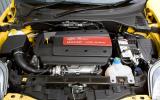There are three good reasons for reviewing the Alfa Romeo Mito Cloverleaf. The most significant is that the Mito was one of the first cars in the Fiat group to benefit from Fiat’s revolutionary Multiair engine technology.
We think that it’s a system worthy of full explanation and evaluation.
Although in time Multiair will also be used on diesel, at the time Alfa is launched with two Multiair models, both petrol: the 1.4TB 135 and the range-topping 168bhp Cloverleaf.
Which leads us to our second motivation: with the rumoured Mito GTA never coming to fruition, the Cloverleaf version could remain the hottest version of the baby Alfa.
But it is the final reason that may be of greatest interest to Alfa fans, because the changes made for the Cloverleaf (new dampers, steering and gearbox) promise to address the areas we criticised most in the Mito’s original test.
If these claims ring true, the Mito could finally be the characterful, desirable and entertaining hot hatch it should have been from the get-go.
used Alfa Romeo Mito Cloverleaf 2010-2011 cars for sale











































